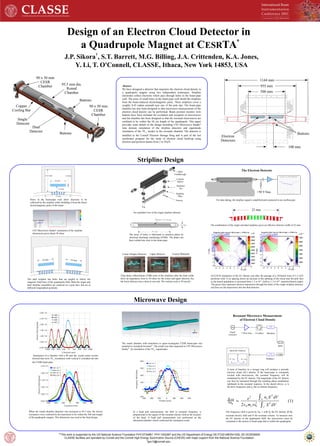
WEPG35_poster
- 1. Design of an Electron Cloud Detector in a Quadrupole Magnet at CESRTA* J.P. Sikora† , S.T. Barrett, M.G. Billing, J.A. Crittenden, K.A. Jones, Y. Li, T. O'Connell, CLASSE, Ithaca, New York 14853, USA Abstract We have designed a detector that measures the electron cloud density in a quadrupole magnet using two independent techniques. Stripline electrodes collect electrons which pass through holes in the beam-pipe wall. The array of small holes in the beam-pipe wall shield the striplines from the beam-induced electromagnetic pulse. Three striplines cover a roughly 0.45 radian azimuth near one of the pole tips. The beam-pipe chamber has also been designed so that microwave measurements of the electron cloud density can be performed. Beam position monitor style buttons have been included for excitation and reception of microwaves and the chamber has been designed so that the resonant microwaves are confined to be within the 56 cm length of the quadrupole. This paper provides some details of the design including CST Microwave Studio® time domain simulation of the stripline detectors and eigenmode simulation of the TE11 modes in the resonant chamber. The detector is installed in the Cornell Electron Storage Ring and is part of the test accelerator program for the study of electron cloud build-up using electron and positron beams from 2 to 5GeV. An exploded view of the single stripline detector CLASSE facilities are operated by Cornell and the Cornell High Energy Synchrotron Source (CHESS) with major support from the National Science Foundation. *This work is supported by the US National Science Foundation PHY-0734867, PHY-1002467 and the US Department of Energy DE-FC02-08ER41538, DE-SC0006505. Stripline Design Microwave Design Holes in the beam-pipe wall allow electrons to be collected by the stripline while shielding it from the direct electromagnetic pulse of the beam. The dual stripline has holes that are angled to follow the magnetic field lines of the quadrupole field. Both the single and dual stripline assemblies are centered on a pole face, but are at different longitudinal positions. The array of holes is fabricated in stainless plates by electrical discharge machining (EDM). The plates are then welded into slots in the beam-pipe. CST Microwave Studio® simulation of the stripline dimensions gives about 50 ohms Resonant Microwave Measurement of Electron Cloud Density A train of bunches in a storage ring will produce a periodic electron cloud (EC) density. If the beam-pipe is resonantly excited with microwaves, the resonant frequency will be modulated by the EC density. The magnitude of the EC density can then be measured through the resulting phase modulation sidebands in the resonant response. In the sketch above, ω is the drive frequency and ωT the revolution frequency. The frequency shift is given by Eq. 1 with ne the EC density, E the resonant electric field and V the resonant volume. To measure only the EC density in the quadrupole field, the microwaves must be contained in the section of beam-pipe that is within the quadrupole. Δ ω ω0 ≈ e2 2ε0 me ω0 2 ∫V ne E 2 dV ∫V E2 dV (1) Center (Single) Detector Upper Detector Lower Detector Time delay reflectometer (TDR) tests of the striplines after the final welds show an impedance close to 50 ohms for the center and upper detector, but the lower detector has a short at one end. The vertical scale is 50 mρ/div. ECLOUD simulation of the EC density just after the passage of a 20-bunch train of 5.3 GeV positrons with 14 ns spacing shows an increase in the splitting of the cloud near the pole face as the bunch population is increased from 1.2 x 1011 (left) to 1.3 x 1011 particles/bunch (right). The green lines represent electron trajectories through the holes of the single stripline detector; red lines are the trajectories into the dual detector. +50 V bias For data taking, the stripline signal is amplified and connected to an oscilloscope. The round chamber with transitions to quasi-rectangular CESR beam-pipe was modeled in Autodesk Inventor® . The model was then imported to CST Microwave Studio® for simulation of the TE11 eigenmodes. Simulation of a chamber with a 89 mm dia. round center section showed that most TE11 resonances with vertical E extended out into the CESR beam-pipe. When the round chamber diameter was increased to 95.5 mm, the lowest resonances were confined by the transitions to be within the 560 mm length of the quadrupole magnet. This dimension was used in the final design. In a bead pull measurement, the shift in resonant frequency is proportional to the square of the resonant electric field at the location of the bead. A bead pull measurement was performed on the fabricated chamber which confirmed the simulation result. †jps13@cornell.edu 22 mm The combination of the single and dual striplines gives an effective detector width of 22 mm. The Electron Detector